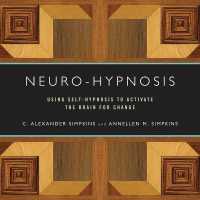Full Description
The movement away from teacher-centered toward student-centered learning and teaching (SCLT) in higher education has intensified in recent decades. Yet in spite of its widespread use in literature and policy documents, SCLT remains somewhat poorly defined, under-researched and often misinterpreted. Against this backdrop, The Routledge International Handbook of Student-Centered Learning and Teaching in Higher Education offers an original, comprehensive and up-to-date overview of the fundamentals of SCLT and its discussion and applications in policy and practice.
Bringing together 71 scholars from around the world, the volume offers a most comprehensive and up-to-date overview of the fundamentals of SCLT and its applications in policy and practice; provides beacons of good practice that display how instructional expertise manifests itself in the quality of classroom learning and teaching and in the institutional environment; and critically discusses challenges, new directions and developments in pedagogy, course and study program design, classroom practice, assessment and institutional policy.
An essential resource, this book uniquely offers researchers, educators and students in higher education new insights into the roots, latest thinking, practices and evidence surrounding SCLT in higher education.
Contents
Introduction and Overview. Part 1: Student-Centered Learning and Teaching Theory. 1: Foundations of Student-Centered Learning and Teaching. 2. Philosophical Problems with Constructivism: Some Considerations for Student-Centered Learning and Teaching. 3: How Student-Centered Learning and Teaching Can Obscure the Importance of Knowledge in Educational Processes and Why it Matters. 4: Learning and Teaching in Harmony with the Brain: Insights from Neuroscience, Biology, Cognitive Science and Psychology. 5. Students as Actors and Agents in Student-Centered Higher Education. 6. Misconceptions and Misapplications of Student-Centered Approaches. Part 2: Student-Centered Learning Processes and Outcomes. 7. Promoting Engagement, Understanding and Critical Awareness: Tapping the Potential of Peer-to-Peer Student-Centered Learning Experiences in the Humanities and Beyond 8. Cautiously Independent: How Student-Centered Learning Encourages Emerging Adults to Take Risks. 9. Student-Centered Approaches to Fostering Media Literacy in College Students. 10. Enhancing Asian Students' Engagement by Incorporating Asian Intellectual and Pedagogical Resources in Teaching and Learning. 11. Transforming a Large University Physics Course to Student-Centered Learning, Without Sacrificing Content: A Case Study. 12: The Powerful Role of Testing in Student-Centered Learning and Teaching in Higher Education. Part 3: Student-Centered Classroom Practices. 13: Emerging Trends to Foster Student-Centered Learning in the Disciplines: Science, Engineering, Computing and Medicine. 14: Student-Centered Learning Through the Lens of Universal Design for Learning: Lessons from University and K-12 Classrooms. 15: Differentiated Instruction as a Student-Centered Teaching Practice in Teacher Education. 16: Person-Centered Theory and Practice: Small Versus Large Student-Centered Courses. 17: Student-Centered Learning: Investigating the Impact of Community-Based Transformational Learning Experiences on University Students. 18: Using Role-Play in Political Science Courses at a Japanese Women's University. Part 4: Student-Centered Spaces and Educational Technologies. 19: Active Learning Anywhere: A Principled-Based Approach to Designing Learning Spaces. 20: Student-Centered Virtual Design Studio Environments . 21: The Virtuous Circle of Learning Design and Learning Analytics to Develop Student-Centered Online Education. 22: Promoting Learning Goals in an Advanced Physics Laboratory via Student-Centered Learning: A Case Study Using the MITx Residential Platform. 23: Effectiveness of a Flipped Classroom Approach When Teaching Lab-Based Techniques. Part 5: Instructor and Student Support Services. 24: Partners in Creating Student-Centered Learning: Case Study of the Derek Bok Center for Teaching and Learning at Harvard University. 25: Student-Centered Learning and Teaching - Lessons from Academic Support. 26: Transitioning from Instructor-Centered to Student-Centered Learning: Case Study of the U.S. Air Force Technical Training Organizations. 27: Finding Our Way to More Student-Centered Teaching in Namibia: The Case of the Postgraduate Certificate in Higher Education. 28: Student-Centered Libraries: Changing Both Expectations and Results. Part 6: Student-Centered Institutional Strategies. 29: A Workshop as a Lever for Pedagogical Change? The Case of Active Learning: From Practice to Theory, and Back. 30: Building a Student-Centered Organizational Culture: Case Study of the Ateneo de Manila University. 31: The Connected Curriculum Framework: Case Study of University College London. 32: Implementing a University-Wide Evaluation System to Promote Student-Centered Learning. Part 7: Student-Centered Policies and Advocacy. 33: Bridging the Policy-Practice Gap: Student-Centered Learning from the Students' Perspectives. 34: Student-Centered Learning from a European Policy and Practice Perspective. 35: Student-Centered Philosophies and Policy Developments in Asian Higher Education. 36: What PISA Tells us About Student-Centered Teaching and Student Outcomes. Conclusion: Beyond Student-Centered Classrooms - A Comprehensive Approach to Student-Centered Learning and Teaching Through a Student-Centered Ecosystems Framework. Epilogue: Usable Knowledge - Policy and Practice Implications for Student-Centered Higher Education


![80-90’s TEENS BEAUTY BOOK [テキスト]](../images/goods/ar2/web/imgdata2/49074/4907462360.jpg)





